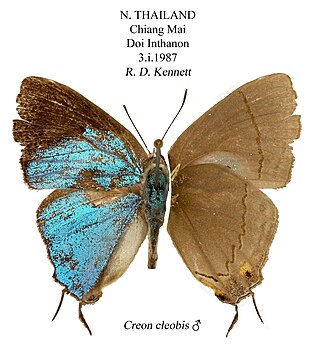
Apamea crenata, known as the clouded-bordered brindle, is a moth in the family Noctuidae. It is distributed throughout the Palearctic realm. In the North it crosses the Arctic Circle, in the Mediterranean it is found only in cool locations and mountains avoiding very hot areas. In the Alps, it rises to an altitude of about 2000 metres.

Miletus symethus, the great brownie, is a small butterfly found in India that belongs to the lycaenids or blues family. The species was first described by Pieter Cramer in 1777.

Apamea ophiogramma, the double lobed, is a moth of the family Noctuidae. It is found in the Palearctic realm in North and Central Europe to the Urals, Turkestan, Russian Far East, and Siberia. There have been at least two separate introductions into North America and it is now rapidly expanding in range. This species is sometimes placed in the monotypic genus Lateroligia.

Hydraecia micacea, the rosy rustic, is a moth of the family Noctuoidea. It is found across the Palearctic realm from Ireland to Siberia. It reaches Japan and is introduced to eastern USA, Quebec and Ottawa.

The broadtail royal is a butterfly in the monotypic genus Creon, in the family Lycaenidae. It is found in South Asia.

Catocala electa, the rosy underwing, is a moth of the family Erebidae. The species was first described by Karl Friedrich Vieweg in 1790. It can be found in Europe and Asia.
Dipriodonta is a monotypic genus of moths belonging to the subfamily Drepaninae and contains Dipriodonta sericea as only species, which is found in India.

Grammodes stolida, the geometrician, is a moth of the family Erebidae. The species was first described by Johan Christian Fabricius in 1775. It is found in Africa, southern Europe, most of Asia and Australia. It migrates to central and northern Europe as far north as England, Denmark and Finland.
Givira plagiata is a moth in the family Cossidae. It was described by William Schaus in 1901 and is found in Venezuela.
Boryzops purissima is a species of moth of the family Erebidae. It is found in the southern United States, where it has been recorded from Florida and Texas, as well as in Veracruz in Mexico, Costa Rica and Jamaica.
Syllepte cometa is a moth in the family Crambidae. It was described by William Warren in 1896. It is found in Assam, India.
Canucha sublignata is a moth in the family Drepanidae. It was described by Warren in 1902. It is found in New Guinea and on the Moluccas.
Habrona marmorata is a moth in the family Drepanidae. It is widely distributed in Papua and Papua New Guinea.
Exaeretia hildaella is a moth in the family Depressariidae. It was described by John Frederick Gates Clarke in 1941. It is found in North America, where it has been recorded from Alberta and the Northwest Territories.
Mecistoptera albisigna is a species of moth of the family Erebidae. It was described by George Hampson in 1912. It is found in southern India, Australia and on Fiji.
Megalopyge tharops is a moth of the family Megalopygidae. It was described by Caspar Stoll in 1782. It is found in French Guiana and Brazil.
Mesoscia dyari is a moth of the Megalopygidae family. It was described by Schaus in 1912. It is found in Costa Rica.
Mesoscia lorna is a moth of the Megalopygidae family. It was described by Schaus in 1905. It is found in French Guiana.

Trosia circumcincta is a moth of the Megalopygidae family. It was described by William Schaus in 1905. It is found in French Guiana.
Podalia thanatos is a moth of the Megalopygidae family. It was described by William Schaus in 1905. It is found in Costa Rica and Guyana.







